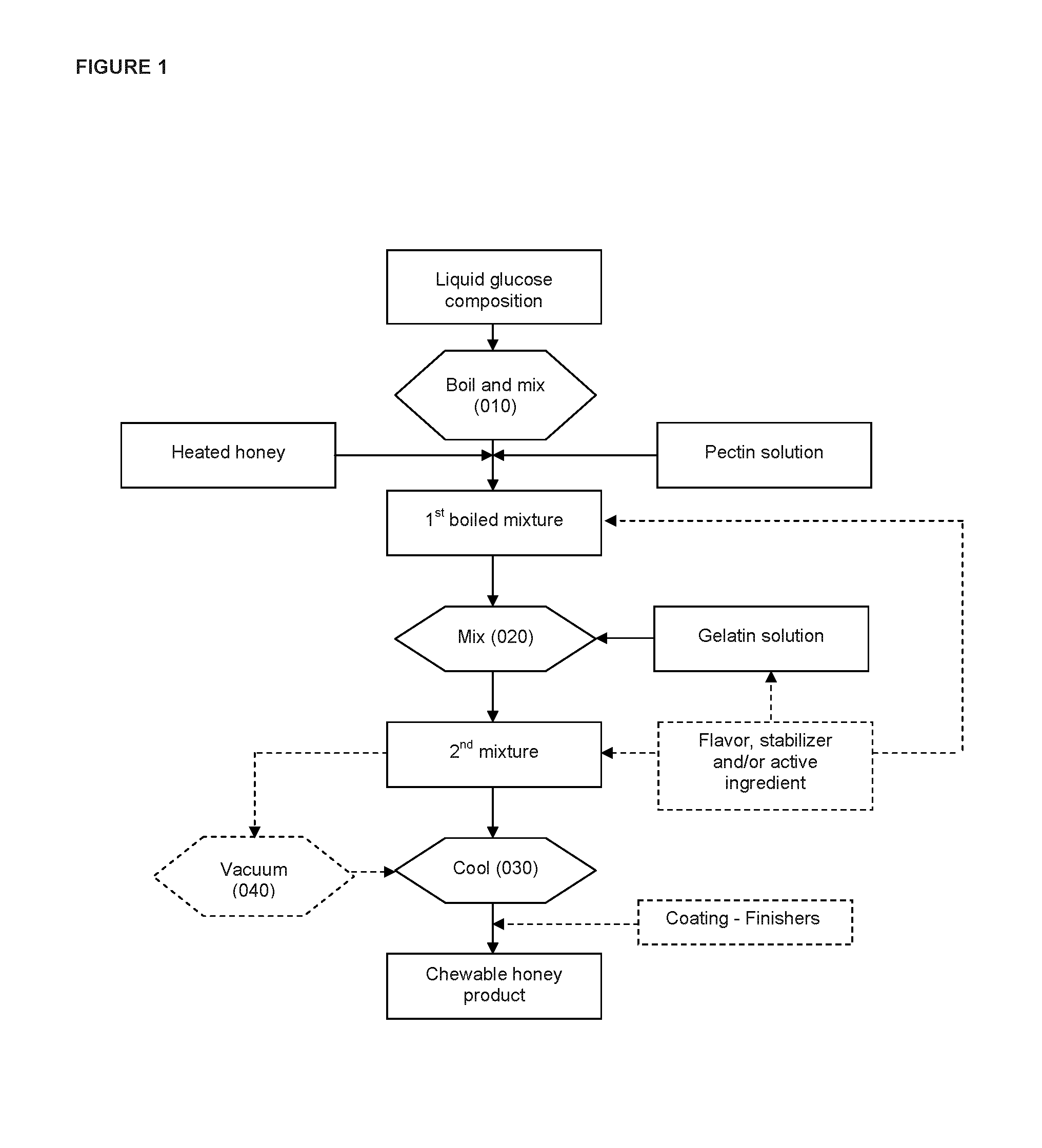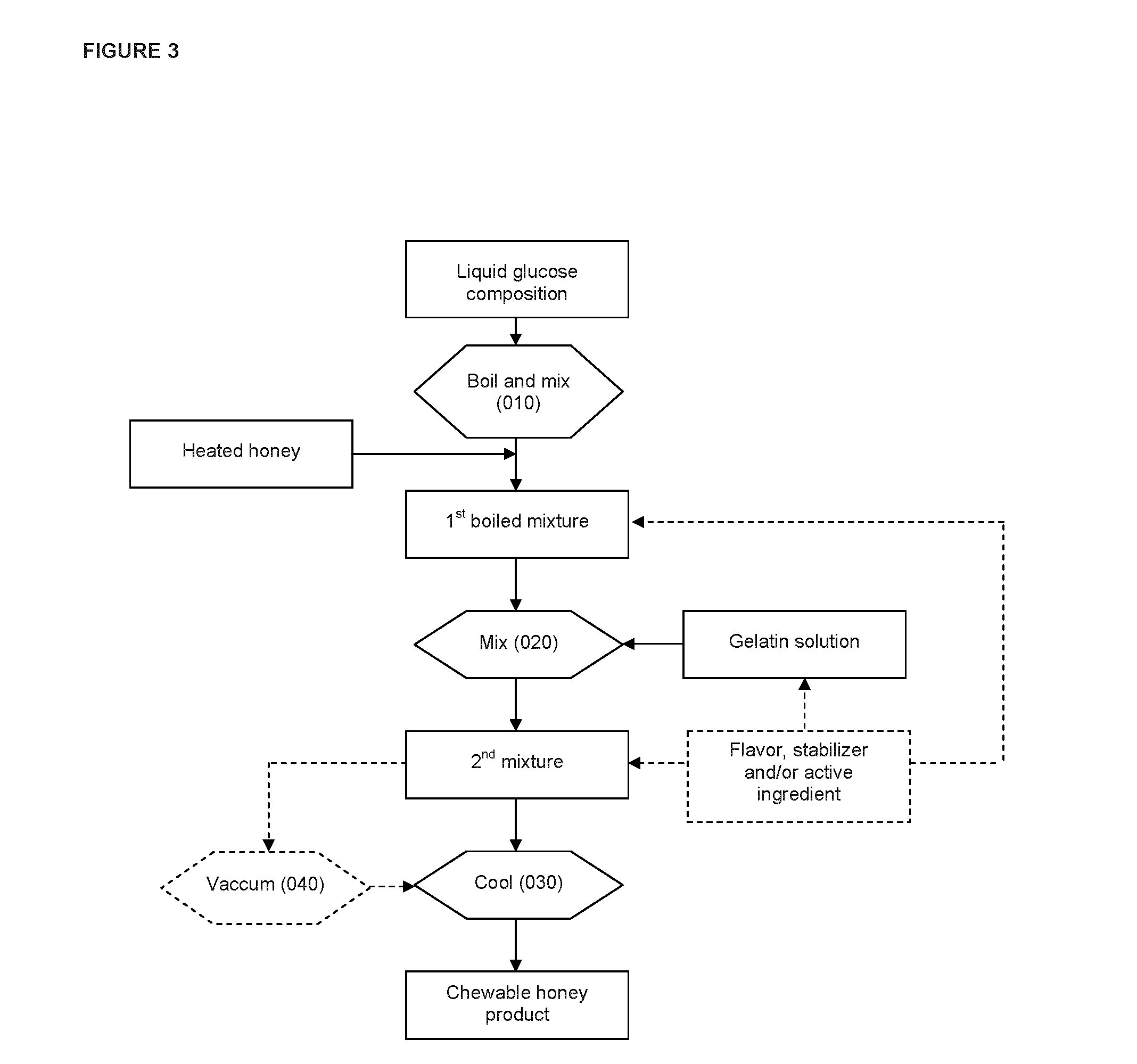Chewable product and process for making same
a technology for chewable products and products, applied in chewing gum, confectionery, food science, etc., can solve the problems of limiting the type of additives
- Summary
- Abstract
- Description
- Claims
- Application Information
AI Technical Summary
Benefits of technology
Problems solved by technology
Method used
Image
Examples
example i
Honey Gummy Having Sorbitol as Stabilizer
[0087]Gelatin (30.2 g) was hydrated with hot water (30.0 g at ˜70° C.) and then allowed to cool. Once the hydrated gelatin was cooled at room temperature, sorbitol (8.9 g) was added to the solution.
[0088]In separate vessels, dried honey (177.3 g having less than 05% moisture) was heated at a temperature which caused its complete liquefaction (96° C.). At the same time, glucose 42DE (76.0 g) was heated at a temperature of 115° C.
[0089]The liquefied honey was added to the heated glucose and the resulting mixture was mixed until an homogenous mixture was reached. The temperature of the honey-glucose mixture was kept at 115° C.
[0090]The gelatin solution was added to the honey-glucose mixture (still at 115° C.). The resulting mixture was mixed slowly until the gelatin solution was completely dissolved.
[0091]A vacuum of 28 inHg was applied to the gelatin-honey-glucose mixture to lower the moisture of the product eliminate potential air bubbles.
[009...
example ii
Processes Using Liquid Honey
[0094]Gelatin (30.5 g) was hydrated with water (61.7 g). The hydrated gelatin was then mixed, at room temperature, with liquid honey (262.4 g having more than 10% moisture). The resulting mixture was placed in a flask and boiled under vacuum. No gummy products were obtained as the gelatin recrystalized under vacuum and the product was hard not chewable in texture.
[0095]Gelatin (30.2 g) was hydrated with water (60.4 g). The liquid honey was brought to a temperature of 250° F. in an open vessel. Once this temperature was reached, it was maintained, the gelatin was added and stirred until homogenously mixed. No gummy products were obtained as the resulting mixture did not form a proper gel (e.g., it was running and not a solid gummy) and the honey was burned.
[0096]Gelatin (30.2 g) was hydrated with water (60.4 g). The liquid honey was brought to a temperature of 250° F. in an open vessel. The gelatin was added and stirred until homogenously mixed. The result...
example iii
Process Using a Combination of Liquid Honey and Glucose
[0098]In this example, in an attempt to prevent the burning of the honey, the formulation was changed to include glucose as a partial replacement for the honey. More specifically, gelatin was hydrated and supplemented with sorbitol. Glucose and honey combined and boiled. The gelatin solution was admixed with the glucose-honey solution. The resulting mixture was poured into molds. The results of these processes are presented in Table 2.
TABLE 2Characteristics of final products obtained by the processesdescribed in Example III using different ratios between glucoseand honey. The percentages of glucose and honey are basedon the full weight of the final product (e.g., a single gummy).% Glucose% HoneyCharacteristics075Honey has slightly burnt flavour characteristics.570Chewable product was obtained1560Chewable product was obtained3040Chewable product was obtained4525Chewable product was obtained705Chewable product was obtained750This ...
PUM
 Login to View More
Login to View More Abstract
Description
Claims
Application Information
 Login to View More
Login to View More - R&D
- Intellectual Property
- Life Sciences
- Materials
- Tech Scout
- Unparalleled Data Quality
- Higher Quality Content
- 60% Fewer Hallucinations
Browse by: Latest US Patents, China's latest patents, Technical Efficacy Thesaurus, Application Domain, Technology Topic, Popular Technical Reports.
© 2025 PatSnap. All rights reserved.Legal|Privacy policy|Modern Slavery Act Transparency Statement|Sitemap|About US| Contact US: help@patsnap.com



